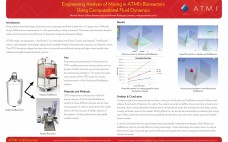After production and purification of biopharmaceuticals generated by cell culture expression systems, endogenous cell line proteins — commonly referred to as host-cell proteins (HCPs) — sometimes contaminate finished products. HCPs can elicit an immune response following administration of those drugs to patients (1), and cause potentially deleterious side effects. It is therefore imperative to minimize HCP contamination in finished biologics. Regulatory health authorities require monitoring of HCP contamination. They expect validation of each purification process to demonstrate its…
Upstream Processing
Think Strategically for Design of Experiments Success
Global competition fueled by the power of information technology has forced the pharmaceutical and biotechnology industries to seek new ways to compete. The US Food and Drug Administration (FDA) has promoted quality by design (QbD) as an effective approach to speed up product and process development and create manufacturing processes that produce high-quality products that are safe and effective (1,2,3). Statistical design of experiments (DoE) is a tool that is central to QbD and the development of product and process…
A Biomass Monitor for Disposable Bioreactors
Of the available on-line biomass assay types, radio-frequency impedance spectroscopy (RFI, often referred to as capacitance) is generally regarded as the most robust and reliable method for monitoring viable biomass during fermentation and cell culture. The first article to show that capacitance could be used to estimate microbial biomass dates back over 20 years (1). Today the technology is routinely used for monitoring and controlling mammalian cell culture processes and high-density yeast and bacterial fermentations in research, process…
The Dinosaurs Reborn: Evaluating Stainless Steel and Disposables in Large-Scale Biomanufacturing
Although a number of biomanufacturers have adopted disposable technologies for small-scale process design, there has been considerable debate over the role of single-use systems in large-scale biopharmaceutical manufacturing— particularly in retrofitting facilities. Some experts have gone so far as to suggest that large-scale stainless steel fermentors are “dinosaurs,” with their large capacities, long installation lead times, and low flexibility. I advocate a systematic approach to look holistically at possible retrofit technologies in existing (stainless steel) facilities, with particular…
Single-Use Systems As Principal Components in Bioproduction
Single-use systems (SUS) have become an accepted component of animal-cell–based bioproduction. No longer a merely exciting possibility, they have emerged as a significant and growing resource for companies to use from process development to manufacturing of approved products. Having been examined for years in less regulated environments, off-the-shelf SUS are now in regular use to some extent in nearly every segment of the production train by contract manufacturing organizations (CMOs) and biopharmaceutical companies in mid-scale production applications. For…
Linear Scale-Up of Cell Cultures
Reusable bioreactors have been the benchmark standard for many decades, during which a large knowledge base on process control and scale-up has been developed. However, single-use bioreactors are increasingly being implemented in modern bioindustrial upstream processes. Many of these bioreactors deviate from the traditional stirred-tank design, but a number of companies have expressed a strong need for single-use bioreactors based on the strirred-tank design. A traditional stirred-tank design would enable users to optimize their scale-up processes based on…
Engineering Analysis of Mixing in ATMI’s Bioreactors Using Computational Fluid Dynamics
The Integrity® PadReactor™ and Nucleo™ systems are a single-use bioreactors specifically designed to fulfill the needs of cell culturists. They are perfectly suited to laboratory environments, process develop¬ment centers, clinical material supply and flexible GMP manufacturing. The bioreactor vessel, which offers comparable functionality to classical stirred tank bioreactors, is a single-use bag integrating an internal paddle mixing and sparger system. This innovative bag design allows a non-invasive connection to the system. The paddle is enclosed in a medical grade ULDPE…
Albumin: A robust pharmaceutical excipient in the stabilization of protein therapeutics
Optimal formulation of peptide and protein pharmaceuticals into efficacious dosage forms to ensure sufficient stability and provide acceptable shelf life is critical. To achieve a stable pharmaceutical drug product, excipients are often added to the protein drug substance. In this study, we investigate recombinant human albumin (rAlbumin) for its ability to prevent or minimize physical and chemical degradation of two allelic variants of the recombinant malaria vaccine candidate, merozoite surface protein 2 (MSP2), in various test formulations. The studies establish…
Viral Vaccine Manufacturing Scale Using the iCELLIstm Disposable Fixed-Bed Reactor
Viral vaccines are usually produced by anchorage-dependent cell lines. At industrial scale, these cells are either cultivated in static mode on multiplate systems (Roller bottles, Cell Factories, Cell Cube, etc.) or on suspended micro-carriers (porous or non-porous) in in bioreactors. Multiplate systems are bulky and require a lot of handling operations, whereas microcarrier cultures require numerous operations (sterilization and hydration of carriers,bead-to-bead transfers) from pr eculture to final process. However most of the currently available disposable reactors are not well…
Cell Culture Design Space Modeling using a Scale-Down Approach
As an industry initiative to “provide assurance of quality,” the ICH Q8 guideline proposes building quality into the design of experiments by defining the process design space within which critical product quality attributes are within an acceptable range. A characterized design space not only enhances process knowledge but also can later be utilized for process validation and regulatory filings, saving on the time and cost of additional filings if process changes are implemented in the future. Because it is neither…




